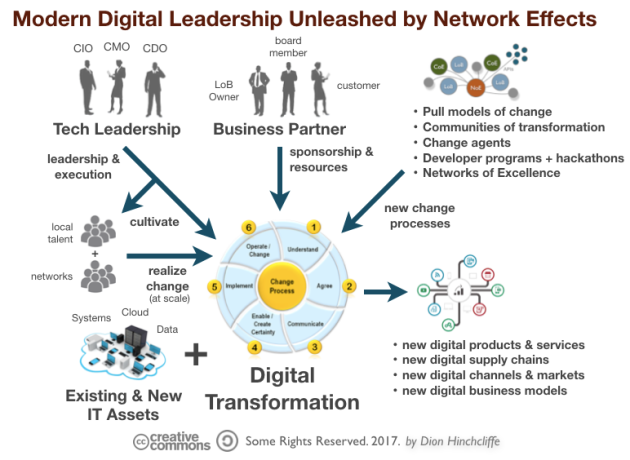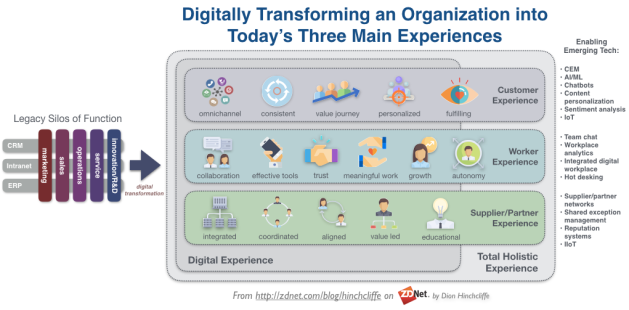Four Strategic Frameworks for Digital Transformation
October 18, 2018 2 Comments
Collectively, the world of business and IT just isn’t learning about effective ways to digitally transform nearly as quickly as it could be or should be. However, as we reflect on previous efforts, we can begin to see why this is: Lack of good storytelling, inadequate structuring for speed and agility, poor sharing of effective best practices harvested from hard-won industry experiences, or having these lessons collected together into understandable and applicable frameworks that reflect the realities of how hard large scale digital change really is.
We almost universally know now we must adapt to the digital future, to change and grow. But how best to do it remains the top question.
We’ve also learned along the way there are numerous submerged obstacles to digital transformation that won’t be denied and must be overcome before we can really even get started. Sometimes, as they say, we must first go slow to go fast later.
Stubborn and long-standing issues related to technology like technical debt or poor master data posture, to name just two, threaten to derail efforts before they even start. Issues related to the nature of people take up the rest, and can sometimes seem intractable.
Four Frameworks to Describe and Drive Digital Transformation
Consequently, in my work advising and/or leading digital transformation efforts, I’ve developed and refined four key frameworks built out of years of repeated use and validation in organizations around the world. These reflect many of the central issues that I believe we’ve learned that we must address and then codified them into a plan that most organizations can execute against. The motivation: I’m asked for what frameworks to use for digital transformation more and more frequently these days. So I thought it would be useful to share them along with some key insights in how they were captured.
The Adaptable Digital Transformation Framework. This originally came from my exploration of the organizational culture issues and long-term journey with digital transformation. It’s also one of my oldest and most seasoned frameworks.
This framework reflects at its core an ongoing cycle of (hopefully, self) disruption, refinement, growth, and renewal, backed by key pillars including culture change, leadership, goals/roadmap, business redesign, communications, education, and skill building. It also makes the key point that emergent innovation is perhaps one of the biggest outcomes, enabled by the key digital era technique of designing for loss of control, such as critical strategy of turning your business into an open platform that others can build on at scale.
A Digital Transformation Initiation Framework. I used to get asked more often than now about how to get started with digital transformation than I do today (as the majority of organizations have already begun in some way.) This framework focuses mostly on the first 100 days of an organization-wide effort and reflects the key activities that must occur.
If there is something I’d tweak about this now it’s the “honesty assess” task in the first column. I’d underscore it far more. That’s because most organizations aren’t going far enough in the deeply reflective examination and soul-searching they must conduct early-on at every level to understand what they’re really facing when it comes to digital change and adaptation. This step must be particularly emphasized in the framework or organizations will struggle to even start the journey. Technical debt and master data barriers are just the start on the technology side. Culture, inclination, skill, and talent are bigger issues and are softer human ones that are very challenging to resolve. For many organizations, these obstacles will take far more than 100 days to overcome.
Other than that emphasis, I’m pleased with the current state of this framework, even if too many organizations don’t take the cultivating and full-scale activation of change agents nearly to the level they should.
A Leadership Framework for Digital Transformation. More of a process flow view than a prescriptive view on how leadership should go about digital transformation, this framework is useful for showing how critical it is for executives and digital change leaders are responsible for defining a new business future state, rich in new products and services in the realm of customer experience and digital platform. The major change I’d make today is that recent data now shows that the CEO is now the leader most often involved in driving forward enterprise-wide digital transformation, and I’d position it so in this picture.
The Digital Transformation Target Model. Less of a framework and more of a description of the transformation journey from silos of function (marketing, sales, delivery, operations, customer service, R&D/innovation) to the three main experiences that must result from a successful digital transformation. Right now, customer experience is the focus, with employee experience a distant second, but supplier experience is finally bringing up the rear and becoming a genuine conversation. I’d not make many changes to this view based on recent lessons learned, and organizations should take this view deeply to heart in their efforts in digitization.
Frameworks: A Living Artifact of Digital Transformation Knowledge
One unfortunate fact is that organizations often developed or adapt their frameworks from the material they encounter, such as the ones above. But they fail to make it a living artifact that captures lessons learned and teach those that must join in and continue the journey.
Thus, if there is a lesson learned above all, is that as digital transformation becomes a long-term journey that organizations will remain on as long as they exist, they must do a much better job in capturing, codifying, and spreading the learning of what works and what doesn’t, as it changes and evolves through time. In fact, learning is ultimately the primary activity of digital transformation, so any successful effort will tend to emphasize it and capture it in their own frameworks.
Additional Reading
The Digital Power Values for The New C-Suite: The Modern Mindset of the CEO, CIO, CMO, CDO, CCO
Why IT Leaders Struggle with Digital Transformation
The Leadership Challenges of Digital Transformation | The Conference Board































































Pingback: A Digital Transformation Framework
Just stumbled upon this piece from 2018; it has aged well and I found it really useful even in 2020 context. Thanks for sharing Dion